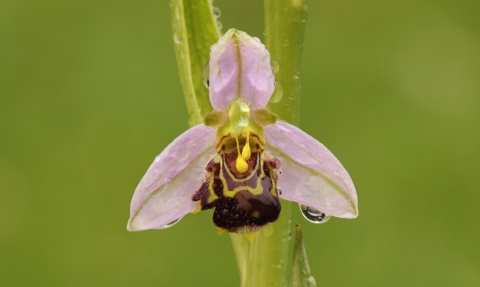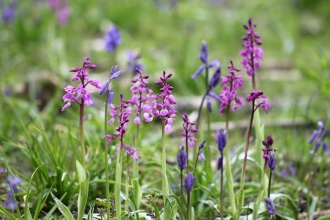
Dawn Monrose
Orchids
What are they?
Orchids are the superstars of the wild flower world. This summer, search for the masters of mimicry cleverly fooling their pollinators, including the furry-flowered bee orchid, or its more understated cousin, the fly orchid. Sample the perfume of a fragrant orchid, or the stink of a lizard orchid. Deep in the woods, look for the bizarre bird’s-nest orchid growing in leaf litter; a parasite that steals its nutrients from the roots of trees, and has dispensed with the green chlorophyll that other plants use to make their food in favour of a creamy-brown colour all over.
Where can I see them?
You can see orchids throughout the UK, flowering between April and September, hitting peak flowering season from May. Tempting as it may be, don’t pick the flowers. Orchids look their best out in the wild, and some species are legally protected so you could be breaking the law.
Heysham Nature Reserve
The diversity of habitats has produced a wide variety of flowering plants with over 215 species recorded, including bee orchid and yellow-wart.
Mere Sands Wood
Wildflowers on site include marsh helleborine, common spotted, early and southern marsh and bee orchids.
Middleton
The fens support an array of orchid species, including early marsh-orchid, southern marsh-orchid and northern marsh-orchid.
Moston Fairway
If you visit in spring or early summer, you can count the spikes of southern marsh-orchids from the path.
Salthill Quarry
Bee Orchid, carline thistle and milkwort can be seen growing on the thin soils in June.
Wigan Flashes
The remaining colliery spoil and ash provide suitable conditions for a wide variety of wild flowers such as common spotted-orchid, marsh-orchids, evening-primrose, pale toadflax and viper's-bugloss.
What to look for
The key to finding orchids is to do your research beforehand: target the right habitats at the right times of year.
On chalk grassland, look for the dense pink flower spikes of pyramidal orchids and the taller, cylindrical spikes of fragrant orchid, which smell sweetly, especially in the evenings. Less ‘fragrant’ and more ‘smelly’ is the lizard orchid. A rarity found at just a few sites in the south of England, this giant among orchids has a spike of gorgeously twisty, spiral-lipped ‘lizard’ flowers, and smells strongly of goats.
More information
Be very careful where you tread: as well as the obvious flower spikes there will be plenty of non-flowering leaf rosettes which you should avoid trampling.







